- RV Sanitation

RV Wall Repair Do It Yourself – Exterior and Interior – Water Damage Wall
Paying close attention to the part of your RV wall that needs repair will help you prevent greater problems and higher costs in the future. In the following, we’ll discuss some of the things, that you need to know in doing the repairs for yourself. If you’re ready, let’s begin and learn how to do some fixes to the wall of your RV.
May you like: Best RV Roof Coating – Rubber Roof Coating for RV Camper Trailer
Table of Contents
RV Interior Wall Repair
The first common issue is interior wall damage. In order to repair it, follow these steps.
Case 1 Changing the paneling

May you like: Best RV Roof Sealant – RV Rubber Roof Sealant
Case 2 Water damage in the RV wall

And for the results, let us try to compare with some before and after photos. Before, with all the mess mold mildew
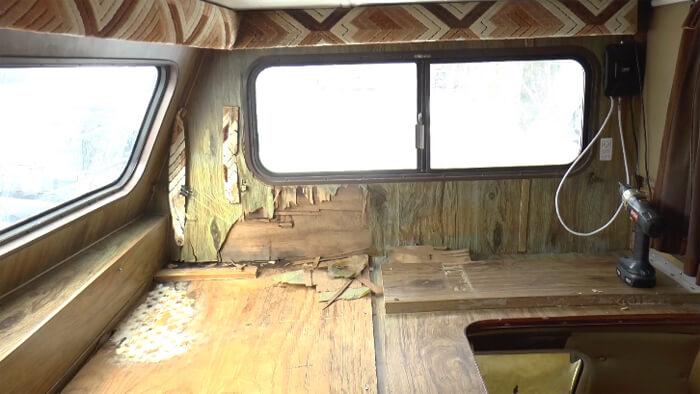
Here is the end result with the new plywood up.
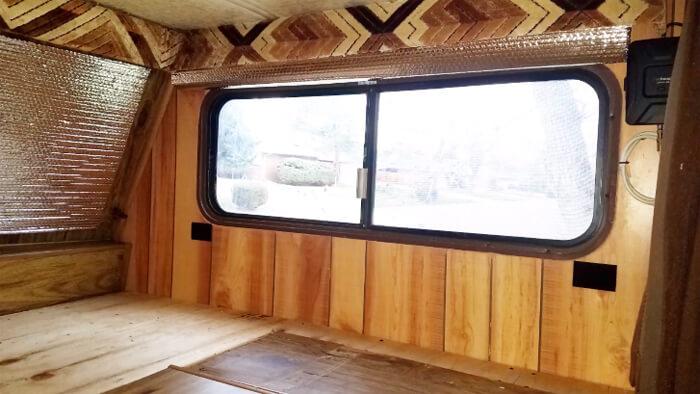
Tips for other cases
Rv fiberglass wall repair.
To make small repairs on the fiberglass wall, prepare the things, including drill, breathing mask, eye protection, gloves, sandpaper, fiberglass repair kit, auto body filler, and foam insulation.
- Wear eye protection, gloves & a breathing mask. Remember that fiberglass can be stuck in your skin. It is also unhealthy to inhale.
- Using a sharp knife, you can cut away the damaged portion.
- Repair the insulation located behind the sliding if deep holed. Use expanding foam insulation on it and let it dry. Sand the excess foam insulation to level it with the rest of the insulation.
- Mix auto body filler, apply to the hole & let dry before sand flushing.
- Repair the fiberglass by applying it over the filler. Allow to drying before sand flushing.
- Paint the repaired area. Choose the correct color of the touch-up paint.
RV Foam Wall Repair
Another walling material to repair in your RV is the foam wall. Here is what you need to do.
- Get rid of the hole debris. Take all the drywall or plaster pieces clinging to the hole’s edges.
- Use some old newspaper to stuff into the hole. Be sure to arrange that at the bottom because it needs to support the spray foam later. Make sure that the area behind the hole is clear.
- Spray foam into the hole but only up to ¾ of the way because the foam will later expand to fill the hole.
- Allow the foam to harden. Usually, it will take up to two hours. After, you can cut flush it to the wall surface with a utility knife before shaping it to concave.
- With a drywall joint compound, use a layer of it to the hardened foam. Scrape the joint compound flat using the utility knife and then letting it dry overnight. Again, apply a coating before scraping to finish the task.
- Start sanding the final coat you have just applied when dried. To finish the job, prime the patch using PVA wall primer before painting it.
RV Laminate Wall Repair
Delamination is one of the major issues that have been plaguing many RV owners through the years. When this happens, there is usually water regression in the Luan, also called the interior panel & the film sheeting outside.
Due to the moisture buildup, the adhesive quality will be compromised, resulting to warping or bubbling found on the surfaces. In some cases, it may be worth repairing but not in all. For the small cracks or punctures, you can repair them or take them to the auto-body repair shop or RV dealer.
With the aluminum siding, you can also find specific gel-coat-type waxes and cleaning products in order to keep the RV looking new.
RV Shower Wall Repair
Check out the following for tips on how to repair the RV shower wall.
- Turn the water supply off.
- Take the shower access panel out. If you cannot find the panel’s location, you should consult the RV manual.
- Locate and reach through the panel space. Disconnect both the cold and hot feeds, the pipes starting from the faucet assembly going to the showerhead, and the vacuum breaker.
- Remove fitted accessories. Remove shower walls. If your RV shower is not sectional, you can take the uppermost piece out first and then work all the way down towards the pan. In some cases, there may be brackets holding the panel to the enclosure. You can find them through the panel hole.
- Lift the shower pan, but avoid damaging the plumbing that carries the used water to the grey holding tank.
- Measure the exact size of the shower enclosure to buy a matching replacement.
- Read and follow the entire installation instructions that come with the replacement shower.
Read more: RV Sewer Hose Fittings
RV Water Damage Wall Repair
For water damage, expect a further challenge in the DIY task. Check out the following steps.
- Prepare a tape, 80-grit sandpaper, 60-grit sandpaper, epoxy resin or wood hardener, putty knife & wood putty.
- Look for water leak sources to prevent more water damage.
- If the leaks are entering through the windows, apply RV caulking.
- You can also patch up exterior siding and roof with waterproof tape. Apply it carefully because it will not come off once its backing sticks to the trailer.
- But for major exterior siding or roof repairs, you might want to ask help from a pro because it is labor-intensive.
- From the inside of the camper, look for all areas with water damage. Check the ceiling, floor & walls for signs as well as mushiness.
- You can also repair damaged wood in the wall by pulling off the loose pieces and smoothing the wood grit remaining using 80-grit sandpaper. Paint or spray-on epoxy resin or wood hardener. It will not just repair and harden the wood but will prevent mold growth, too.
- Apply wood putty after 24 hours in order to harden the wood. Use putty to fill the wood indents that resulted from the water damage. Dry the wood putty and sand it using 60-grit sandpaper to smooth it.
- Install the new paneling or wallpaper.
There you have some of the most common wall problems and fixes you can do yourself. But in the case of major repairs, you might want to seek help from a pro. Read more: Best RV Toilet Paper Eco-Friendly, Septic Safe & Clog-Free RV Toilet Tissue

I like that you said that in order to repair a fiberglass wall you need to have tools, such as a mask, fiberglass repair tool, auto body filler and many more. My friend talked about fixing the interior of his RV. I’m going to suggest to him about taking it with a professional that has all the tools needed.
This is a great how-to that you wrote up here. Now for me and my trailer, I need to get some of the panels repaired. I think if I followed your guide, I could manage to do some of them myself. However, they are badly damaged so it might be best to go with a professional for this one.
Mark, I usually add some L shaped steel brackets along the exterior walls and to the new flooring to increase the stability of the walls when traveling. This allows one to simply replace the flooring up to and not beneath the walls.
It’s helpful that you said to wear eye protection and a breathing mask so that fiberglass doesn’t become a problem. My trailer has a giant crack in the wall so I’ll be sure to fix it soon. I bet these tips will be helpful!
Some repairs need professional expertise but some repairs can be done easily with Liquid RV Roof. Liquid RV Roof is a true DIY product which can restore the old RV roof at a fraction of cost of roof replacement. With only a single coat it also saves labor and material costs. Serving the rv industry for over 27 years.
I am doing a remodel on my class A and I thank you for your information and definately people, wear a mask and glasses, there isn’t much worse than fiberglass particles in your eyes or mouth (been there!) also the wood, mold, potential rodent feces, and bugs are to be considered as well! Peel and stick wallpapers and tiles are great for bathroom and kitchen walls after your new panel is in place, they are smaller walls and easier to work on and nicely separates living areas without much fuss.
I have a pop up camper with water damage on one corner which is were the bracket to raise the top is located. The bolts from the bracket have started to tear through the interior wall. The damaged area is about 24″ across the top. Any ideas on how to repair this section of the wall and the bracket that is attached?
Your email address will not be published. Required fields are marked *

- Resource Library
Special until April 30th: 30% off Solvent & Cleaner for the month of April. Use Code APR24 at checkout. *restrictions apply
Free ground shipping in the Continental US for any orders over $150!
How To Repair RV Water Damage In The Wall...
How to repair rv water damage in the wall.
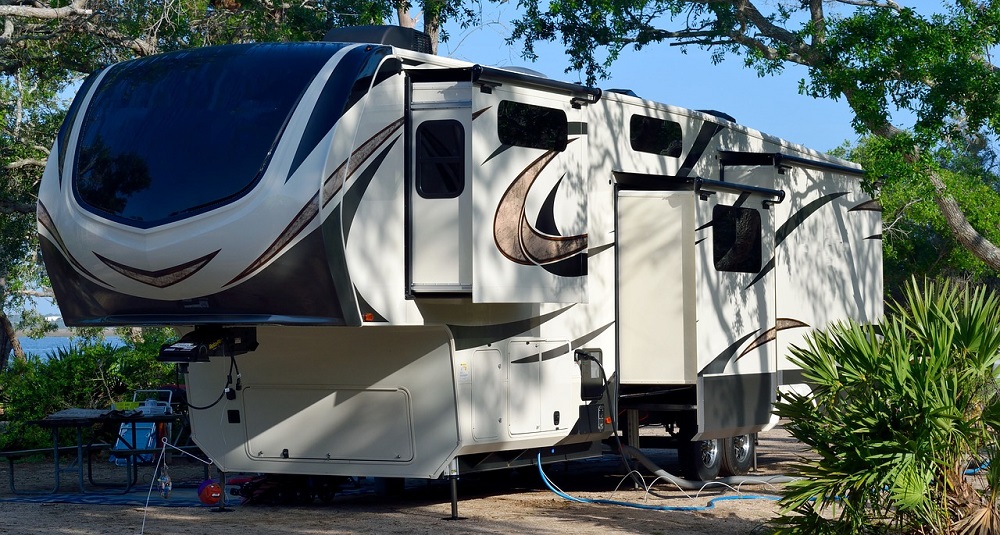
Few things on earth scare RV owners more than water damage located in the wall. This damage is unsightly and can lead to more serious problems—and more costly solutions—when not addressed. The good news is that if you spot this damage quickly, you can stop it in its tracks. But that’s only possible if you know how to attack it. Here’s what you’ll need to know to repair RV water damage in the wall.
Step One: The Leak
If water has entered your RV walls, then your primary problem may not be the effect just yet. It’s the cause of all that water. Where did the water come from? Is there a leak on the outside that needs addressing? On the inside? Take your RV somewhere safe and dry, and have a look around the area. Use a flashlight—even in the daytime—so you can check out any dark areas and corners that might be suspect.
As you search for the leak, don’t forget that some leaks might appear invisible—that is, they might appear under areas, such as where the window meets the wall. Wear a pair of gloves and be prepared to give these sections a touch to see if there are any loose parts that might give you a clue. Once you’ve identified where the leak is, you’ll be able to tell whether it’s something you can patch up yourself—or if it’s an area that may need total replacement. If you caught the leak early, you should be able to patch it up yourself.
Step Two: Find The Right Sealant
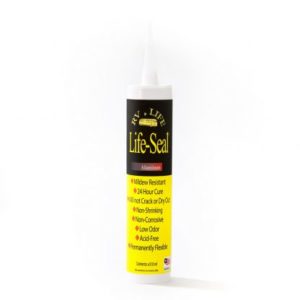
- Life Seal® Silicone/Polyurethane Sealant . Formulated especially for fiberglass but will adhere to metal, wood, Lexan®, and ABS®. This product is also available in different colors—including clear—at our RV sealants page.
- Life Calk® Polysulfide Sealant . Can be applied to damp surfaces, which is great for water leak repair. Bonds to fiberglass, wood, metal, glass, and even itself.
- Silicone Sealant . Fiberglass, plastic, metal, and wood. Often used on rubber roofs, but versatile enough for use in certain RV walls as well.
If you’re dealing with exceptionally damp surfaces, use Polysulfide Sealant to ensure proper adhesion. If you notice a leak in fiberglass, the Silicone/Polyurethane Sealant will have best results. Apply as directed on the label to repair RV water damage in the wall, and make sure that you don’t plan on using your RV for at least 24 hours. This allows time for a proper cure. You can often sand and paint on these sealants once they’ve cured—but make sure you read each individual product label first.
More Great Solutions For RV Repair
Want to ensure that your RV looks as good as new? Then continue browsing all the RV cleaning and restoration products here at RV by Life.
Share this:
- Click to share on Twitter (Opens in new window)
- Click to share on Facebook (Opens in new window)
Related Blogs
Thanksgiving trivia.
Thanksgiving is one of America’s oldest and most loved holidays. Even though the story is steeped in a dark history […]
Rv’ing With Your Pets
Today, more than ever, people are traveling with their pets and including them in activities, such as vacations. Pet Travel […]
The Ultimate Camping Bucket List
When you think campgrounds, KOA probably comes to mind as you can find KOA’s all over the United States. Well, […]
All products proudly made in the usa
How To Repair Rv Wall Water Damage
Having water damage in your RV can be a frustrating and costly problem to deal with. Whether it’s from a leaky roof, a plumbing issue, or a crack in the wall, water damage can cause mold growth, rot, and structural damage. However, with the right tools and approach, you can repair RV wall water damage and restore your vehicle to its former glory. In this article, we will guide you through the step-by-step process of repairing RV wall water damage.
Materials You Will Need
Before diving into the repair process, make sure you have the following materials on hand:
- Plastic sheeting
- Plywood or particleboard
- Screwdriver or drill
- Sanding block
- Patching compound
Step 1: Identify and Fix the Source of Water Damage
Step 2: remove damaged materials.
Next, you need to remove the damaged materials. Carefully cut away any wet or rotted areas using a screwdriver or drill. Be sure to wear protective gloves and goggles during this step as you may encounter mold or mildew. Dispose of the damaged materials properly to avoid spreading the contamination.
Step 3: Dry the Area
Step 4: replace insulation and structural support, step 5: install new drywall, step 6: patch and sand, step 7: prime and paint.
Step 8: Caulk and Seal
Frequently asked questions on how to repair rv wall water damage, how can i repair water damage on my rv wall.
To repair water damage on your RV wall, start by identifying the source of the leak. Once fixed, remove the damaged area, replace with new material, and seal it properly.
What Are The Common Causes Of Rv Wall Water Damage?
The common causes of water damage on RV walls include leaking windows, damaged seals, faulty plumbing, roof leaks, and improper drainage systems.
Can I Fix Rv Wall Water Damage Myself?
Yes, you can fix RV wall water damage yourself by following a step-by-step process. However, it’s important to assess the extent of damage and seek professional help if needed.
How Long Does It Take To Repair Rv Wall Water Damage?
The time it takes to repair RV wall water damage depends on the severity of the damage. Minor repairs can be completed in a few hours, while major repairs may take several days.
Can Water Damage Affect The Structural Integrity Of My Rv?
Yes, water damage can weaken the structural integrity of your RV. If left untreated, it can lead to rot, mold growth, and further damage to the walls, floors, and other components of your vehicle.
Repairing RV wall water damage may seem like a daunting task, but with the right materials and step-by-step approach, it can be done successfully. Remember to identify and fix the source of the water damage, remove the damaged materials, dry the area thoroughly, and replace the insulation, structural support, and drywall. Patch, sand, prime, and paint the repaired area, and seal it with caulk. By following these steps, your RV will be back in great shape, ready for your next adventure.
Leave a Comment

How to fix RV water damage

- BEGINNERS GUIDE
G. Yoganand
Water damage in RV is a very bad thing. It can create health problems from the resulting mold and the repairs can be costly. Sometimes the repair costs can be so high that they could be higher then the RV itself.
To makes things worse, most RV insurance plans do not cover water damage. Thus, any repairs resulting due to such issues lead to costs from your own pocket.
Water leaking in from loose seals on roof, windows or vents starts the water damage. Water can also leak from slide out, floor or cracks on walls .
For any residence, but for RV’s in particular, water damage is major. And can be detrimental not only to your health but to the structure.
It can become unavoidable and if the water damages the machinery within the RV then it can ultimately become not fit for purpose and will be unusable. Therefore it is essential that if and when you find water damage that you know how to fix it.
One can fix minor water damage in RV but for major repairs a professional help will be needed. Identifying the water damage in initial phase therefore, can save you from costly repairs.
Water damage on floor, if left unattended, can ultimately lead to major issues which cannot be fixed easily and will need floor replacement.
It can become hard if you just ignore it. Therefore, its always better to fix it on time.
In this article, we will see detailed steps for fixing such damage.
Steps for fixing water damage in RV
Before implementing the repairs its always better to get to the root cause. This will save you from more repairs later on.
Identify the leak
Find the cause of the water leak and repair the leak before repairing the damage that it has caused. If you do not repair the cause of the damage before repairing the damage then the next time that there is rainfall, more damage will occur to your recreational vehicle.
It is common for most leakages to occur from the windows or the roofing and thus, windows should be checked and the caulking redone if necessary.
The roofing and exterior walls should also be checked. And be repaired as efficiently as you can by using a strong bonding waterproof tape to put an initial stop to the leak before calling out a professional who can stop and repair the roof or walls for you.
Overall cost of fixing the water damage in initial stage can be less. But, if you ignore it, the later cost can be high.
Check out below video that shows how the water damage repair can be done. In travel trailers or other RVs, this is how you should approach the repairs on your own.
Now lets see the steps in doing the repairs on water damage.
1. Soak up water
If the damage has gotten inside of the recreational vehicle then you should try to soak up as much of the water as is possible .
2. Allow damaged wood to dry
It is inevitable that any leak within your recreational vehicle will cause damage to wood within the vehicle. Thus it is important that you allow all of this wood to dry out fully before you start to repair it.
3. Attend to the features of any water damaged area
It is essential that any small loose pieces of wood or any areas of wallpaper are pulled off as soon as they are spotted within any areas that are damaged by water.
4. Apply a wood hardener to any water damaged wood areas
These can either be painted or sprayed directly on to the water damaged wood area and this will penetrate deep into the wood and harden in order to prevent wood rot. It is essential that you wear a mask and open all available windows when using these products and that upon finishing, you let the hardener dry for a twenty-four hour period.
5. Apply wood filler to water-damaged areas
After the wood hardener has completely dried, you should apply wood filler with a putty knife or similar instrument. This will help to fill in any holes or cracks that have appeared as a result of the water damage. Once applied this should be left to dry for a four hour period.
6. Use sandpaper to sand the dry wood filler
Using fine grit sandpaper, sand the wood filler to smoothen and even out the surface of the wood, in order to get the wood to a state that it can be decorated again.
7. Redecorate
After the repairing, you can then stain or paint the wood, or apply wallpaper to decorate the recreational vehicle back to your tastes and choices.
8. Be thorough
Don’t just cast an eye over areas, run your fingers and hands over door jambs and windows seals, both inside and outside the RV as well as the seals of the roof.
How to identify if its the water damage
The first thing that RV or motorhome owners need to know is that whether you think your RV has a leak or not, you should always check for any signs of water damage to your recreational vehicle. It is essential that owners know what water can do to an RV. And what to do when water damage is found as water is the quintessential silent killer of recreational vehicles, as it may be there without you even knowing about it.
What is most affected
Water damage is commonly found within the wooden structures of the RV such as inside cabinets, compartments or cupboards, under windows or any areas of the outward exterior that has got a hole or been pierced in any way. Consequently, it is important that any owner always casts a watchful look over the RV to check for bubbles or bumps in the wood or paneling of the vehicle, dark coloration of the wood, issues with the fiberglass or any stains.
Water damage can occur at any part of the RV but it is more likely to occur at below locations .
- Under windows
- Inside compartments or cabinets
Doing regular checks and inspecting for cracks, loose seals, or other signs at these locations can help you in quickly identifying and fixing it.
Look for signs
Another sign of water damage is that of discolored or wrinkling wallpaper or rusting of the screws and nails within the RV, as well as rust stains or discoloration that occurs around or underneath the window areas.
To know if your RV has water damage, look for below signs:
- Discoloration, specially near windows, door or ceiling.
- Delamination of fiberglass.
- Soft softs on the floor.
- Wrinkles on the wallpapers.
- Stains or dark rotted wood on the RV body.
- It feels damp and usually produces musty smell.
Water damage will not always be visible to the eye. And so occupants may notice with other senses such as smell, as water damage can give off a musty smell that occupants should appear to notice as well as discoloration amongst the tops of the walls or upon the ceiling and areas of the floor that can feel spongy to walk over.
Rotted floor repair can be hard and costly as well. If the damage is too much you may have to replace the floor. Check this guide on steps to repair the rotted floor.
Preventing Water damage in camper
The main thing to remember is that water damage should never be ignored. It should always be repaired in order to prevent wood rot, and if found on time water damage can be fixed at relatively low expense. However, even if the damage was detected late and has already caused the wood to rot, it is still repairable.
As well as the wood, any carpeting or flooring such as linoleum or vinyl can also be taken up and replaced if damaged by any water. It is also possible that if severe water damage has occurred then the whole wall or roof may need to be replaced. If that is the case then do not be scared to rip out the wall or ceiling in order to remove the decay from your vehicle, as all damage must be removed including any parts that appear soft or to be rotting.
RV leaks occur mostly at locations that have openings like roof, windows, under the cabinets and slide out. On the roof, around the areas with roof vents, antenna and AC, the caulking seals may dry up and allow water to leak. Same is the case with window or slide out seals that may allow water to leak in with time.
To avoid such leaks make sure you redo seals before they worn out.
If it is the framework that appears to be rotten then it may be possible to cut out the rotten piece carefully rather than taking out the whole framework.
How much is the damage
Hopefully, you have been lucky and been able to ascertain where the leak is coming from. However, if you have not been that lucky, when the next rainfall hits, go inside your RV and try to find where the leak is coming from. This will enable you to patch up the leak to prevent any damage.
Once you have patched up the leak it is recommended that you wait for dry weather. Then leave the RV or travel trailer to dry out completely. Make sure the windows remain open to release moisture from the air.
Before we conclude on this guide, let me point out few things that will save you from major costs in repairs.
✔️ Focus on finding leaks and get them fixed as early as possible. Most leaks go unnoticed which later results in major water damage issues.
✔️ Do regular checks preferably before and after winter/rainy season. Check for seals and replace if needed. If putting the travel trailer in storage, make sure you repair all the cracks, gaps.
✔️ Avoid harsh weather as far as possible.
✔️ Do not park travel trailer with low hanging tree branches or anywhere that can result in damage to the roof or walls.
✔️ When buying a used camper make sure to avoid those with water damage. Try to avoid old rigs that are older than10 years. Such old travel trailers are highly prone to water damage and therefore, avoiding them will be your best decision.
Holidaying in a recreational vehicle is an amazing way to take a holiday although it is important that it is always checked and repaired if necessary. Water damage, unfortunately, is part and parcel of owning a recreational vehicle. However it does not have to be the end of the world.
RV insurance companies do not include the water damage and thus doing regular checks to prevent leaks is utmost important.
If any of the signs of water damage are caught and repaired early enough then it can save you a vast amount of money. It is essential to note that RV’s are often moving around and as a consequence, the vibrations of the road could cause seals to open and condensation and water to seep in and damage your vehicle. However, water damage is nothing to be afraid off and after reading this article you should have a firm knowledge base on how to deal with your water problems.
You Might Also Like
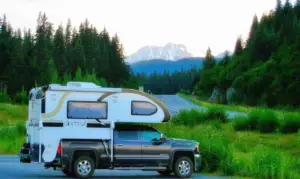
How To Insulate a Truck Camper
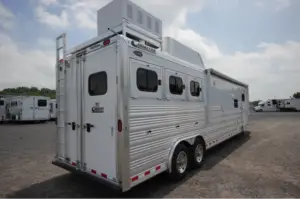
Why do rvs have ladders ? (And should you get one installed ?)

What Makes Airstream Trailers Expensive and Popular
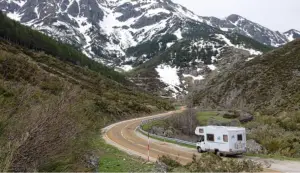
How many mpg does RV get

Where You Make It

Repairing, Replacing, or Upgrading Your RV Walls
Hey! This site is reader-supported and we earn commissions if you purchase products from retailers after clicking on a link from our site.
What if you have some sort of damage to one of your RV’s walls due to weather issues such as water, hail, or snow; are you prepared to tackle the repair of that damage by yourself? Would you like to remodel or upgrade your interior design by replacing an interior or relocating an inner wall and you’re not sure how to do that task?
If you answered yes to those questions, be sure to read on. In this article, I’ll guide you through how to repair damaged walls and how to redesign or remodel an existing wall if you’ve recently purchased a used RV and you want to upgrade its design. We’ll also look at what tools, hardware, and materials you’ll likely need to do the upgrades and the needed repairs.
First, find out where the leak is
The most important aspect when addressing water damage in your RV is to find out where your leak is and what’s the best solution for making the necessary repairs. Quite often, the source of the leak may be in a place several feet away from the damaged area in the wall, so you’ll need to thoroughly inspect your RV prior to making your repairs.
While the general rule for free-flowing water is to take the path of least resistance, if a seam on your roof only allows a minuscule amount of moisture into its opening, then it’s likely that path could change between times of leakage and the path could also change based upon how level your RV is parked or whether you’re diving in the rain.
As a rule, you’ll find that most water damage in a wall is the result of a leak in your roof. This is likely to cause water stains on your ceiling and staining high on your wall or at its base. However, it’s also possible to have leakage through your flooring and the water staining will be concentrated at the base of your walls. With that said, I would recommend that you first inspect your flooring by getting under your RV and search for any deterioration nearest to where you suspect that water is getting into your rig.
If you discover that there that there are no leaks in your flooring, the next step is to inspect your roof. For this task, you’ll need to properly access your roof and I recommend that you avoid using a manufacturer installed ladder at the rear of your rig. Why? Because there could he structural damage to the roof that won’t hold your weight.
Instead, a better option would be to use an adjustable and foldable ladder that can be easily stowed away with any other essential tools you’ll likely need when traveling. Whether you’re a full-time RVer or a part-timer, I recommend that you always carry a ladder to access the roof area of your RV when needed.

- Dimensions - Max A-frame height: 5'1'' | Max Extension Height: 11' | Max scaffolding height: 3' |...
- The Velocity also includes several innovative new features such as the dual-pin hinge and the...
- The Velocity can be used in many unique configurations as an a-frame, extension, staircase and...
Last update on 2024-04-06 / Affiliate links / Images from Amazon Product Advertising API
Inspecting your RV roof can be tricky. Depending upon the manufacturers and their various design guidelines, there may will be a wall and sealing seams which is usually covered up with a J-rail. This, and cross seams that seal the interior areas of your roof are likely to cause issues with your RV’s roof. The trick is identifying those breeches and properly repairing them. In a future article, I’ll share my tips on the best ways to seal your roof to prevent any water leaks.
Once you have located the source of the leak and have properly sealed it, now you’ll need to tear into your wall to make the necessary repairs. To begin, locate the nearest wall panel seam to your damaged area. If there are floor or ceiling moldings, you’ll need to remove these before you begin to remove any paneling. You’ll also need to remove any electrical outlet and switch covers too.
Removing your wall panels
As I have said in numerous other articles, RV manufacturers typically don’t use the most expensive materials when building RVs. And they’re also built with time efficiency in mind. Don’t be surprised if you find that your wall panels have been attached to the studwork with building staples. If this is the case, you should have a pair of pliers, a hammer, and a flat-head screwdriver on hand because you’ll need to pry the screwdriver under the staple by lightly tapping on the screwdriver handle (a small wood chisel works well for this too) then pull up on the chisel or screwdriver and this should one or both sides of the staple free of the studwork. If only one side of the staple is freed, then use your pliers to completely remove the staple. Repeat this process for each stud until the panel can be removed. If your damage is located in the front upper panel (and sometimes a rear panel) it’s likely that you’ll encounter a radius so try to save this part of the old panel to use as a template when cutting your new replacement panel. In fact, do your best to preserve the old panel so you’ll know where any openings for windows, or outlets are located as well.
If your panel has been attached using finishing nails, it’s likely that as you pry the panel away from the studwork, that the panel will pull away but not the nail since finishing nails don’t have a large head on them like most other nails have. If this is the case, after you have removed the panel, you’ll need to use the claw side of your hammer to pull the nails free.
Another option for removing nails is to use a wrecking pry bar. These are inexpensive and a great option when removing small nails.
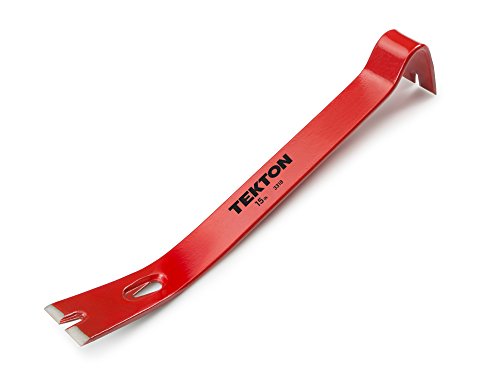
- Versatile, all-purpose contoured bar with broad flat end and high-leverage rocker end
- Thin, sharpened chisel tips slide easily into the tightest cracks and crevices
- Three nail slots (one at each end, one in the middle) lets you get at nails from any angle
Before you begin to replace your damaged panels, be sure to inspect any insulation in your wall for damage too. When you’re replacing an entire panel, it’s likely that not all the panel will have water damage nor will the insulation or any other components such as wiring. However, I’m a firm believer that once you have taken something apart, you should inspect anything you can and make the appropriate changes or upgrades when you can.
For example, this is a great time to modernize your rig if it’s an older model. Frankly, if I were doing a restoration of any RV, I would make sure to close the repair only after I have replaced any fiberglass batting used for insulation. Instead I would replace that batting with foam panels which is much easier to work with and less likely to have a mold buildup if it’s exposed to a little moisture.
This is a good time to inspect any electrical outlets or switches for loose wiring or shorts as well. This also will give you an opportunity to install additional outlets for 12-volt wiring such as USB charging lines for cellphones or laptop computers as well as any other wiring you may want to update.
Replacing your panels
There are literally hundreds of options when choosing to replace your RV panels. For me, I find the looks of wood grain very appealing and while I prefer a more natural look than this red oak stained panel shown here and available from Amazon, this 4’x8’ panel does come unfinished making it a good option for someone like me that would prefer to stain it a lighter shade. Here is an oak furniture guide you might find helpful.

- REAL WOOD VENEER SHEET – Unfinished and ready for stain and/or finish. Veneer provides stability...
- PREMIUM QUALITY – Gives you confidence that the wood will be right for your project
- EASY TO USE – These veneer sheets are easy to cut to the size you need and are easy to finish +...
While some folks may decide to cut corners and apply a panel like this directly onto the studwork, I would recommend first attaching an underlayment of 1/8” plywood. Adding an additional layer of wood panel will in turn add strength, more soundproofing, and most importantly, another barrier for natural elements such as heat in the summer and cold in the winter.
As I said before, the options are practically endless when deciding on your wall’s design. For example, some people prefer a wood panel they can paint or apply wallpaper to. Other people prefer to apply a wood panel then add peel-and-stick panels over that, while some people prefer to use tongue and groove panels. Do your research and find what works best for you.
One tool I would recommend when replacing paneling on you RV is an electric or an air nail gun. These save a lot of time and since finish nails are small and hard to hold by hand, they are far more efficient when nailing your panels in place. Additionally, you are less likely to damage your paneling using a nail gun as opposed to a hammer.

- 🔰CONVENIENCE --The electric nail gun/staple gun doesn't need compressors or hoses, which makes...
- 🔰WIDE APPLICATION -- The nailer/stapler is ideal for Softwood DIY projects such as carpentry,...
- 🔰Safety Design -- The 18 gauge brad nailer is designed with On/Off power switch, safety contact...
Final thoughts
As with any DIY project when working on your RV, the more you do them, the better your work is over time. Be patient as you work and if you don’t understand something, do some additional research or seek out the advice of others that are more knowledgeable than you. Remember, most do-it-yourself RVers are a friendly bunch and usually glad to pass along any advice to those with less experience. If you’re doing some wall paneling in a van, make sure to read Lindsey’s article on van wall paneling during her van conversion process.
I have spent years learning how to restore, remodel, and maintenance RVs . That knowledge didn’t come to me overnight and while the internet is a valuable source for newbie RVers, not everything you may need to know is as easy as a click or two away on your laptop.
Thanks again for following along my friends. Stay safe, stay healthy, and I hope to see you out on the road someday.
Related Articles:

Born and raised in Michigan, contributing writer Brian C. Noell is a retired hospitality industry professional that now works remotely as a visual artist, writer and photographer as he travels around the United States in an RV with his dog Lizzy, an eighty pound Appenzeller hound dog.
How to Restore Your RV After Water Damage

TL;DR: After RV water damage, locate and repair leaks, clean out dirt, remove damaged parts like floors and walls, replace seals on windows, remove mold with bleach solution, air out thoroughly, and replace damaged areas with quality parts to restore your RV. Regular inspections help prevent water damage in the future.
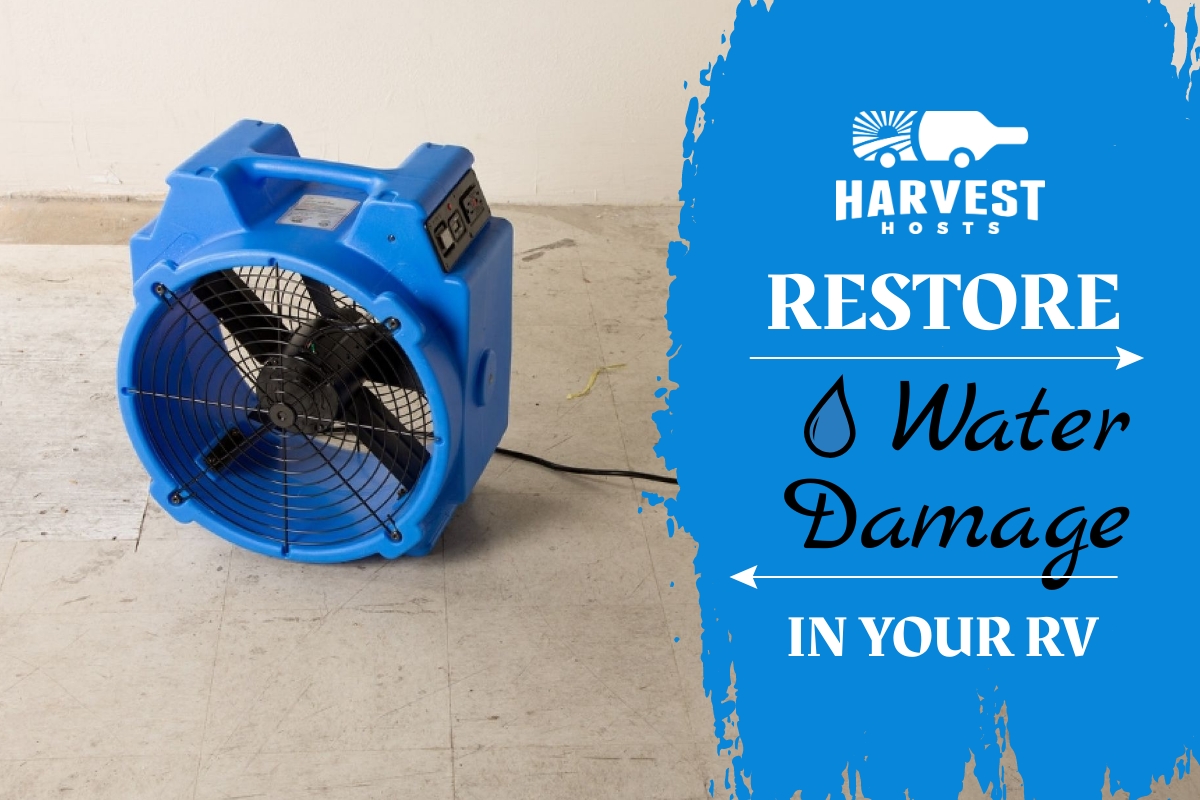
Having a recreational vehicle brings a lot of convenience to life. You can travel in both style and relaxation, bringing with you some of the comforts of home. Getting an RV, of course, will require quite an investment. Hence, you really need to keep it well-maintained if you want to make the most out of it. You may want to even remodel your RV over time. We do understand, though, that there might be instances where you will have RV water] damage. Here are some helpful tips on how to restore your RV after water damage.
Locate and Repair the Source of RV water damage
There might be differences between the extent and resulting damage of water between one that happens in your home and what happens in your RV. A complete RV renovation is not always necessary. However, the first step to resolving both will always remain the same. You need to locate and repair the source of water.
Here are some points to focus on during your inspection:
- Check if there are any leaks especially along the walls, roofing, and toilet area.
- See if there are any soft spots, especially along with roof vents or where areas of the roof have been cut off in order to install AC units, TV antennas, and plumbing.
- Any discoloration and wrinkles on your wallpaper especially around windows, doors, and other openings is a tell-tale sign that seals are dislodged and are not properly keeping water and humidity out.
- Don’t forget to check the cabinets and compartments as well.
- Finally, don’t just do these inspections if you suspect that there’s water damage already. Do so regularly, especially during the rainy season, or you have met exceptionally muddy roads during your travels.
Clean Out Dirt
Speaking of mud, there’s bound to some dirt and grime that comes with it. Don’t wait for it to completely dry if you want to minimize staining as much as possible. You can also take this opportunity to assess the damage as you’re going through each of the areas of your RV since it will allow you to determine between simple staining from actual discoloration.
Remove Damaged Parts
Once you have identified the damaged areas, the next thing is to remove them. This will potentially stop the damage from spreading and even allow you to salvage other parts that haven’t been reached yet. One has to understand that water damage encourages mold growth , and it does spread. It can even severely affect the indoor air quality of your RV and make passengers sick—something that we want to avoid.
RV floors are typically made of plywood. This material is exceptionally vulnerable to water damage . You’ll find that older models are even more so since they’re not made with the extra layer of protection that newer models are designed with.It’s not that elegant, but the best way to check for rotting is to get down on your hands and knees and push towards your flooring. Be on the lookout for flexing or softer, mushier parts. You can even use a screwdriver to push through the exposed wooden elements of your floor to see if any part is deteriorating as well. There’s no way to salvage rotting wood. The only way to restore rotting floors is to replace them completely.
As we have mentioned above, you should be on the lookout for water staining, discoloration, and wrinkling wallpaper. Stripping off your wall covering will also help reveal any damage that’s happening underneath.
What we like about windows is that you don’t usually need to replace them. Most of the time, you only need to replace its seals .
That is unless you’re dealing with a broken window or an issue other than water damage. If that’s the case, then you would really need to replace it. Fortunately, it’s actually very easy to do. Here’s a quick guide:
- Make sure that you have the proper dimensions of your window opening (and not your old window).
- Align the foam tape seals under the window instead of on top of it.
- Spray your foam seal with water before installation. It will help to strengthen its water resistance.
- Install your window from the outside. Push it flat, then screw securely to the inside frame.
- While you're at it, why not update your RV window treatments !
Remove Any Mold Growth
Mild to slightly severe cases can still be remedied with a cleaning formula made from four parts of water and one part of bleach. Mix it thoroughly, pour into a spray bottle, spray directly to the problem area and let it soak for a while before scrubbing off.Really severe cases, however, might require the assistance of a mold remediation company. Should you choose to handle the removal and cleaning job on your own, though, just remember to wear the proper personal protective gear such as a face mask and a pair of gloves.
Air Out Until Thoroughly Dry
Once you’re done cleaning, rinse off the bleach solution with soap and water and allow your RV to air out until it’s completely dry. You can also invest in getting an air blower . It’s a piece of equipment that provides additional ventilation through the use of pressure. It is helpful in drying out interiors and even drying out the excessive moisture that can cause water damage.
Replace All Damaged Areas
Finally, the only thing that you need to do now is to replace the damaged parts that you have removed earlier with new ones. Try to invest in quality parts as much as you can. While they might cost more, they will also last you longer and prevent the extent of water damage that you’ve just experienced from happening again.
Restoring RV Water Damage
There are various ways to prevent your RV from water damage. Constantly expecting your vehicle for leaks and faulty seals regularly, for instance, can already save you a great deal of inconvenience.If water damage does happen, though, then know that there are ways in order to restore your RV to its former glory. Inspect for damaged parts to identify the source of the issue. Remove severely damaged parts. Clean off the moldy residue. And of course, replace the damaged parts with new ones. We wish you safe travels!
- Class A Diesel
- Class A Gas
- Fifth Wheels Sales
- Explore Our Collection of Travel Trailers
- Testimonials
- RV Repair & Service
- (425)710-0064
- (866) 710-0064

How to Repair RV Water Damage
- »

Water damage is a common occurrence in older RV vehicles. Water can seep into several areas that can lead to extensive damage to the interior of the RV, the appliances , or electrical components. For these reasons, it is essential to repair water leaks when they appear to prevent further RV water damage.
How to Check for Water Damage in Your RV
Knowing the areas that are susceptible to water leaking in an RV is crucial to prevent the damage it can cause. Here are some tips on how to check for water damage in areas around an RV.
Check All of the Seals
Checking the seals around various parts of the RV is vital to controlling possible water leaks. This refers to seals for doors, hatches, and other areas that come into contact with the natural elements.
Open the Cabinets and Closets for Smell of Mold
Open all cabinets and closets in an RV to check for smells that indicate mold or mildew. These substances become present due to constant exposure to water. Therefore, smelling mold or mildew in RV cabinets and closets indicates a water leak.
Look for Any Discoloration in the Walls, Wood Cabinets, and Ceiling
Exposure to water can cause discoloration or stains on areas of the RV’s walls, cabinets, and ceilings. Seeing these stains in and around the RV is a strong indicator of water leaks. If the RV starts to show these signs, inspect these areas immediately to find the affected area.
Check the Outer Walls
The outer walls of the RV can sustain significant damage that can result in potential openings that let water in. These causes can range from simple deterioration of the exterior to possible damage caused by flying debris or collision. Therefore, it is imperative to repair RV water damage walls.
Move the Carpets and Check the Underside if They Are Not Glued Down
Water leaking can reach the carpets of an RV. The damage may be hard to detect if the vehicle sits for an extended period when this occurs. Check the underside of the carpet, if possible, for potential water damage that indicates a leak.
Check Doors and Windows for Rusted Areas
Water leaks from doors and windows frequently happen when exposed to rain or snow. Check for rust in these areas to determine if water is leaking through and causing damage to the RV.
Examine the Roof and Ceiling
Much like the outer walls, checking the roof and ceiling of the RV is crucial to identifying water leaks. Finding these areas can prevent damage.
How to Repair Water Damage in RV
When water damage occurs, it is essential to repair the area before the issue becomes worse. Here are common tips to restore and repair floor, ceiling, and RV roof water damage.
Clean Out Dirt
Clean dirt and mud as quickly as possible to prevent discoloration to the floors of the RV.
Remove Damaged Parts
If there is water damage in the RV, remove the impacted areas immediately to protect the remaining components. Mold can spread, so ensure you perform a thorough inspection and eliminate all potential items with mold.
Check the stability of the floor for potential damage. Soft or mushy flooring is a sign of water damage and requires complete floor replacement.
Discoloration and stains are an indicator that an RV requires wall stripping and replacement.
When windows begin to leak water, a simple fix is to re-seal the area. This will prevent water from leaking in.
Remove Any Mold Growth
Mold growth is dangerous to the health of anyone exposed to it. Therefore, removing any mold growth in an RV is crucial by cleaning the area with a cleaner containing bleach.
Air Out Until Thoroughly Dry
After thoroughly cleaning the RV, make sure to air out the vehicle. This will prevent overexposure to moisture, which can lead to more mold.
Replace All Damaged Areas
If an area in the RV sustains damage, it is vital to replace them with quality products as soon as possible to prevent mold from spreading.
Contact Kirkland RV Sales at (425) 318-7613 today for more information on repairing RV water damage!
Recommended Article : Identifying RV Water Damage
You can follow any responses to this entry through the feed.
Kirkland RV Sales 13111 Hwy 99, Everett, WA 98204 Phone: (425) 903-3257 Fax: (425) 710-0504 Toll Free Phone: (866) 710-0064 Recent Listings
- 2006 BIGFOOT 30MH27DSL 3000 Series Class-C, Leveling Jacks, 2-Slides
- 2019 FORESTER 2421DS Trekker Cap Class-C by Forest River, 2-Slide-Outs
- 2019 VISTA 29VE Class-A by Winnebago, Sleep-6, Full-Wall-Slide
- 2017 VIEW 24G Class-C by Winnebago, Mercedes Diesel, 2-Slide-Outs
- 2009 Winnebago ERA 170XL Limited Class-B, Mercedes Sprinter Diesel
“You guys are terrific! Once again we were treated like royalty! The guys fixed our steps to our coach so we can now get in to our rig. Having lunch on your porch was really a treat! We are so impressed with your kindness. Again, thank you so much!”

“Very helpful follow through on items sold will help you out if you are having a problem so much better going here then the big dealers you wont regret it”
Kirkland RV - Contact Us About This RV Today!
Please leave this field empty.

- TripAdvisor
- Testimonials
- Travel Tips
The Assumption Belfry and Ivan the Great Bell Tower

View from a corner of Assumption Cathedral on the architectural ensemble of the Assumption Belfry (at the left) and Ivan the Great Bell Tower (at the right) built in the Moscow Kremlin in 16th century. The tower’s name implies that it had once housed St. John’s Church, and that it used to be the tallest building in Moscow (height with cross is about 80 m). For many decades the bell tower was also the main watchtower in the Kremlin, and later also a fire tower. Petrok Maliy, the Italian architect who built the Kitai-Gorod wall in Moscow, started the construction of the church of the Resurrection, later renamed Church of the Nativity, next to the Ivan the Great Tower in 1532. Decades later was converted to a four-tier belfry for large bells, known today as the Assumption Belfry after its main 64-ton bell placed in the middle of the fourth tier. The Assumption bell tolled only on great holidays and to announce events of exceptional significance.
Photo #043 taken on June 29, 2016 during a tour of Moscow Kremlin with my dear client from Lebanon, Jacques Saade.
About Me in Short

My name's Arthur Lookyanov, I'm a private tour guide, personal driver and photographer in Moscow, Russia. I work in my business and run my website Moscow-Driver.com from 2002. Read more about me and my services , check out testimonials of my former business and travel clients from all over the World, hit me up on Twitter or other social websites. I hope that you will like my photos as well.
See you in Moscow!
- View full size
- Owner: Moscow Guide & Driver
- Date: June 29, 2016 05:14:00 am EDT
- File name: ALP-2016-0629-043-Assumption-Belfry-and-Ivan-the-Great-Bell-Tower-Moscow-Kremlin.jpg
- Tags: Russia , Moscow Kremlin , Kremlin Towers , Ivan the Great Bell Tower , Belfry , Assumption Belfry , Assunmption Bell , Moscow
GPS Location of the Photo
Google maps.
- GPS Map of this album
- GPS Map of Moscow Guide & Driver's pictures
Random image

At the Pier of Park Zaryadye in a Spring Morning
Overview of the pier of park Zaryadye from Moskvoretskaya embankment with a view of the pedestrian hovering bridge over river Moskva (Moscow), Bolshoi Moskvoretsky bridge and the architectural ensemble of Moscow Kremlin in the early sunny spring morning.
Featured Tags
- 273 photos are tagged with architecture
- 199 photos are tagged with cathedrals
- 305 photos are tagged with churches
- 294 photos are tagged with Dear Clients
- 260 photos are tagged with lights
- 1875 photos are tagged with Moscow
- 306 photos are tagged with Moscow by Night
- 194 photos are tagged with Moscow cityscapes
- 264 photos are tagged with Moscow Kremlin
- 326 photos are tagged with night moscow
- 426 photos are tagged with Orthodox Churches
- 226 photos are tagged with Red Square
- 2538 photos are tagged with Russia
- 209 photos are tagged with twilights
- 350 photos are tagged with Winter
Take one of these exciting tours:
- Moscow Highlights
- Discovering the Golden Ring of Russia
- Arts & Culture Tours
- Moscow by Night tour


IMAGES
VIDEO
COMMENTS
Read more: RV Sewer Hose Fittings. RV Water Damage Wall Repair. For water damage, expect a further challenge in the DIY task. Check out the following steps. Prepare a tape, 80-grit sandpaper, 60-grit sandpaper, epoxy resin or wood hardener, putty knife & wood putty. Look for water leak sources to prevent more water damage.
00:00 Intro01:54 6 R's of Water Damage08:59 Floor Repair13:52 Wall Repair18:11 Ceiling Repair22:47 Roof RepairConnect with me: https://linktr.ee/fallenintoca...
Showing you how I replaced the water damaged and rotted wood wall with new wood panels from start to finish. Amazon links to the products I used and promote...
Maintaining the structural integrity of your RV is key when repairing RV wall water damage. Window removal, if necessary, is pretty easy by removing the screws surrounding the window. Replacement of the seals is very important to reduce the risk of a leak. This DIY RV window replacement article goes into more detail.
Repair water damaged wood frame, walls and ceiling in your RV, trailer or camper. ... Repair water damaged wood frame, walls and ceiling in your RV, trailer or camper. It is not as expensive as ...
With assessment and preparation complete, it's time to start replacing damaged sections, drying out the wall cavity and rebuilding the wall's surface. Step-01: Remove Damaged Sections. - Carefully cut and pry away any water-damaged wall panels or wallpaper using a putty knife or pry bar. Take care not to damage framing.
If you're dealing with exceptionally damp surfaces, use Polysulfide Sealant to ensure proper adhesion. If you notice a leak in fiberglass, the Silicone/Polyurethane Sealant will have best results. Apply as directed on the label to repair RV water damage in the wall, and make sure that you don't plan on using your RV for at least 24 hours.
Repair RV Water Damage Wall Repair. One of the most common problems with a travel trailer is water damage. As often as the camper is in the elements, you should expect to have damage within the first year of service. The most common spots to find damage are around the joints, and anywhere there has been a hole punctured.
Step 1: Identify and Fix the Source of Water Damage. The first step in repairing RV wall water damage is to identify and fix the source of the problem. Inspect the entire RV for any signs of leaks, cracks, or damaged areas. Common areas prone to water damage include the roof, windows, and plumbing connections. Once you've identified the ...
Repairing water damage in an RV is essential to maintain its structural integrity and prevent further issues like mold and rot. Here are some general steps to guide you through the process of repairing water damage in an RV: - Identify the extent of the damage: Before starting any repairs, carefully inspect the entire RV to assess the areas affected by water damage. Look for soft spots in the ...
Repair water damage on a travel trailer. Now lets see the steps in doing the repairs on water damage. 1. Soak up water. If the damage has gotten inside of the recreational vehicle then you should try to soak up as much of the water as is possible . 2. Allow damaged wood to dry.
First, find out where the leak is. The most important aspect when addressing water damage in your RV is to find out where your leak is and what's the best solution for making the necessary repairs. Quite often, the source of the leak may be in a place several feet away from the damaged area in the wall, so you'll need to thoroughly inspect ...
June 30, 2020. TL;DR: After RV water damage, locate and repair leaks, clean out dirt, remove damaged parts like floors and walls, replace seals on windows, remove mold with bleach solution, air out thoroughly, and replace damaged areas with quality parts to restore your RV. Regular inspections help prevent water damage in the future.
Any water that makes its way past the exterior surfaces has the potential to be inside the walls. If there are signs of water damage on the surface, you should proceed to check behind the surface. RV slide-out water damage repair should be done properly and the water damage removed completely. RV slide-out wall paneling can be a pain to remove ...
Though this is a different kind of video than we typically make, we thought we'd share how we replaced our RV wall after experiencing water damage.Ever have ...
Here are common tips to restore and repair floor, ceiling, and RV roof water damage. Clean Out Dirt. Clean dirt and mud as quickly as possible to prevent discoloration to the floors of the RV. Remove Damaged Parts. If there is water damage in the RV, remove the impacted areas immediately to protect the remaining components.
Buying an RV can mean freedom, but it also comes with high repair costs for any water damage. RV water damage repair costs between $20 and $2,800, depending on the source and extent of the damage.
Contact Moscow Maples RV Park. 8291 East Chicago Rd. Moscow , MI 49257. Get Directions.
We had a flooded house due to a broken pipe. They took care of everthing and billed the job directly to my insurance…. 2. Service Master Co. Water Damage Restoration Janitorial Service Carpet & Rug Cleaners. Website. (208) 882-5326. 427 Troy Rd. Moscow, ID 83843.
Residents of a Moscow region town impacted by power outages have taken to the streets, demanding that local authorities restore heat to their homes as subzero temperatures grip the region, Russian ...
We repaired the water damaged slide wall frame around the slide out in our 34.5 Forest River Salem Toyhauler. Check out the blog version here:http://twolamb...
View from a corner of Assumption Cathedral on the architectural ensemble of the Assumption Belfry (at the left) and Ivan the Great Bell Tower (at the right) built in the Moscow Kremlin in 16th century. The tower's name implies that it had once housed St. John's Church, and that it used to be the tallest building in Moscow (height with cross ...
Quick RV Repair on a Rotted Wall...1999 Fleetwood Wilderness 33' Fifth Wheel recreational vehicle. This is NOT a how-to video on fixin' RV's, but a how-we-di...